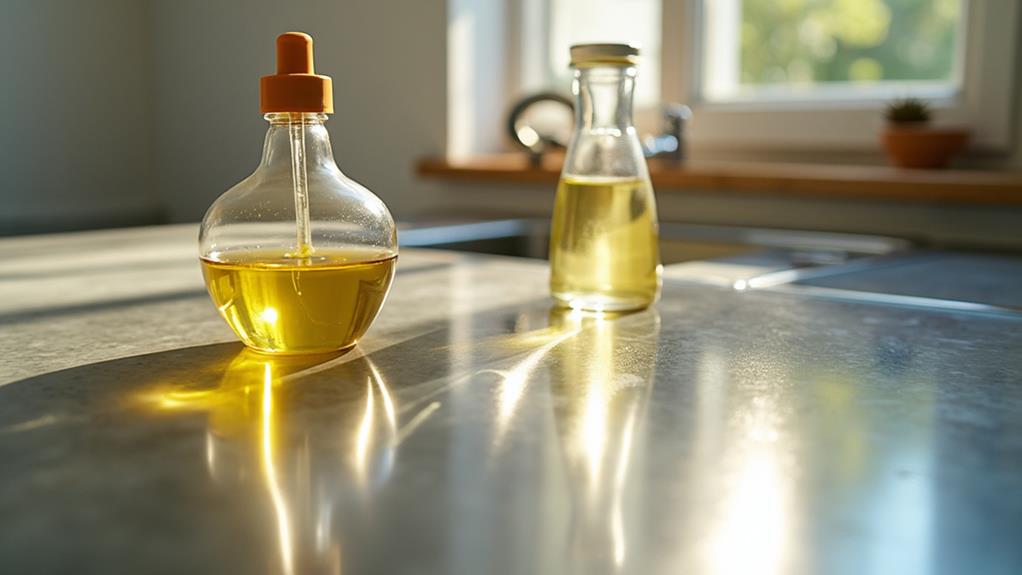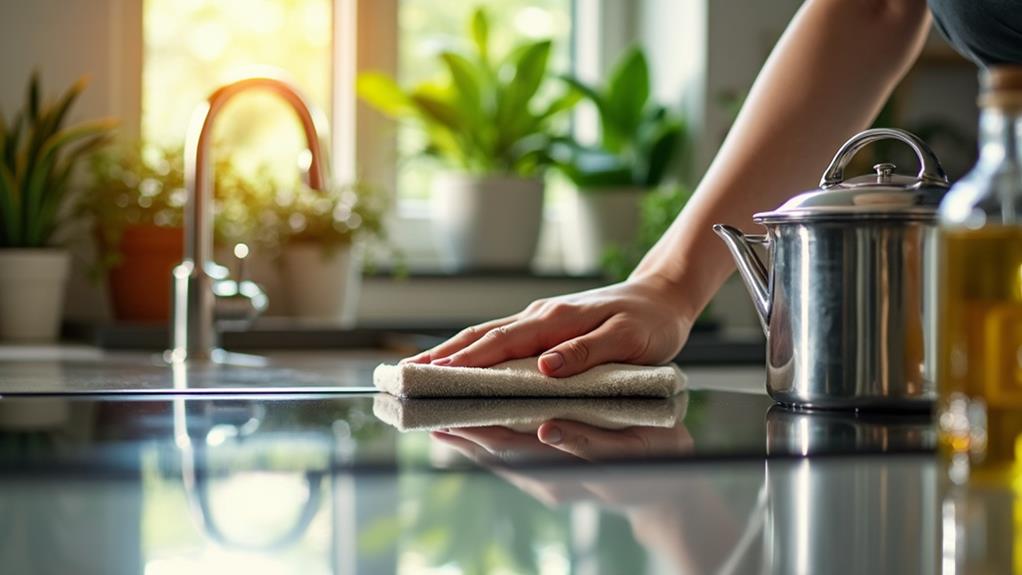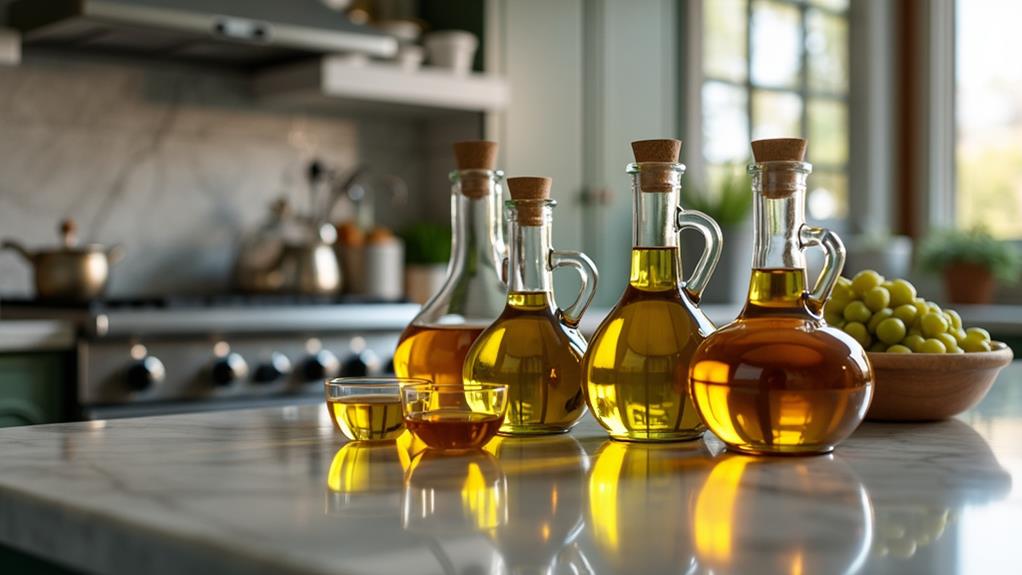How to Clean and Protect Stainless Steel Appliances With Oil
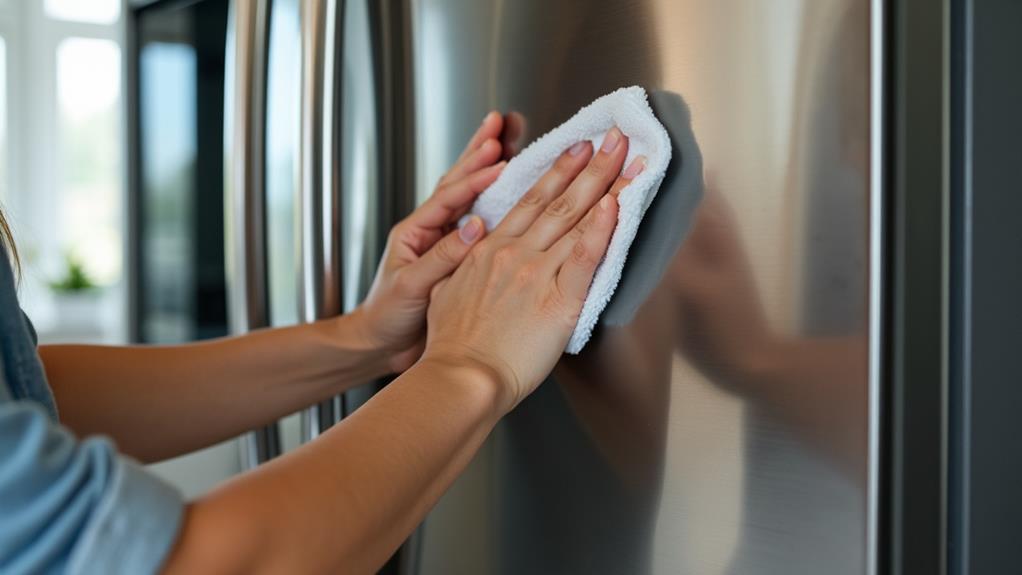
Maintaining the pristine look of your stainless steel appliances can be challenging due to frequent fingerprints and smudges. An effective method to clean and protect these surfaces involves using oil. You will need mild dish soap, olive oil or baby oil, and microfiber cloths.
Start by pre-cleaning the surface with mild dish soap to remove grime. Then, apply the oil using a microfiber cloth, following the grain of the stainless steel for a protective and shiny finish.
Let's go through each step to keep your appliances looking their best.
Common Challenges
Maintaining the pristine look of stainless steel appliances can be challenging due to fingerprints and smudges, which often make surfaces appear dirty shortly after cleaning.
Traditional methods may leave streaks or require excessive scrubbing, leading to frustration. Using a damp cloth can sometimes worsen the situation by creating a mushy appearance instead of a polished finish.
Household activities, particularly those involving children or pets, can further increase grime on stainless steel surfaces. This often results in repeated cleaning, only for smudges to reappear almost immediately—a common issue for many homeowners.
Many commercial cleaning solutions may not provide satisfactory results, prompting a search for more effective and affordable alternatives. One such remedy involves using oil, which we'll discuss later.
For now, it's important to recognize that protecting your stainless steel appliances from constant fingerprints and smudges requires a reliable cleaning strategy. Traditional methods mightn't suffice, emphasizing the need for alternative approaches to keep your appliances looking their best.
Why Use Oil
Using oil to clean stainless steel appliances offers several benefits that can significantly enhance the longevity and appearance of your kitchen. By applying oil, you create a protective barrier on the stainless steel surfaces that helps repel fingerprints and smudges, keeping your appliances looking cleaner for longer periods. Olive oil, in particular, is an excellent choice because it is non-toxic and environmentally friendly, making it a safe alternative to harsh chemical cleaners.
Oil acts as both a cleaner and a polish, boosting the shine of your stainless steel appliances without damaging the surface. A thin layer of oil minimizes the need for frequent cleaning by preventing dirt and grime from adhering to the surface. This not only keeps your kitchen looking pristine but also helps prolong the life of your appliances by preserving their finish and preventing corrosion.
Here's a quick comparison:
| Benefit | Description | Example |
|---|---|---|
| Protective Barrier | Repels fingerprints and smudges | Olive oil |
| Natural Cleaner | Cleans without harsh chemicals | Baby oil |
| Boosts Shine | Polishes and improves appearance | Olive oil |
| Non-toxic | Safe for you and the environment | Olive oil |
| Prolongs Life | Prevents corrosion and preserves finish | Any oil |
Using oil is a simple yet effective way to maintain the beauty and longevity of your stainless steel appliances.
Materials Needed
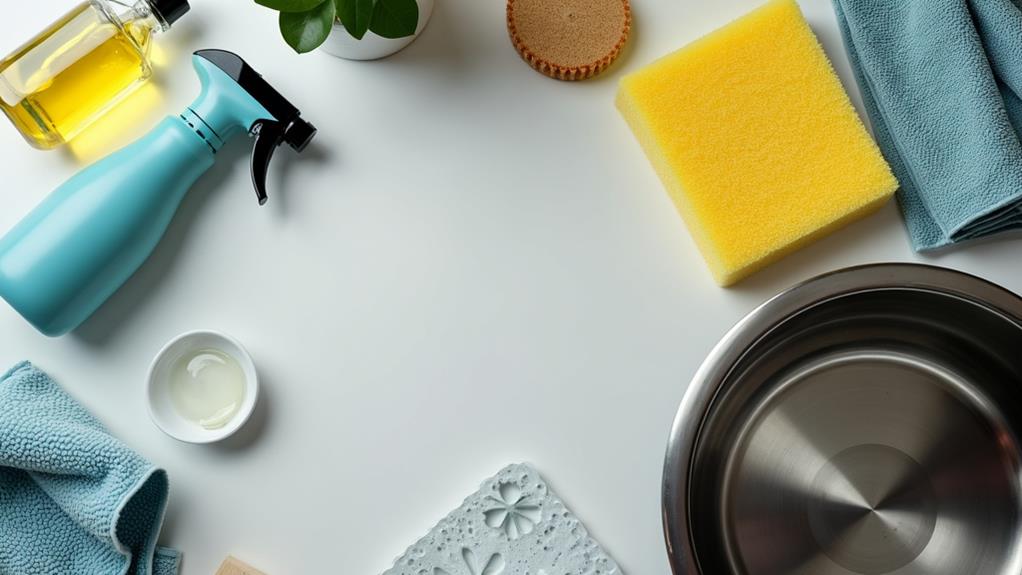
To get started, gather baby oil or olive oil, as both are effective for polishing and protecting stainless steel appliances. You'll need a few microfiber cloths for applying the oil and achieving a streak-free finish.
Additionally, have dish soap and water on hand for pre-cleaning, and paper towels or dish towels for the final buffing.
Baby Oil Benefits
Baby oil is a remarkably effective and budget-friendly solution for cleaning stainless steel appliances. This inexpensive agent excels at removing fingerprints and smudges, leaving surfaces spotless. Simply apply a small amount of baby oil to a soft cloth to achieve streak-free results.
Regular use of baby oil not only cleans but also enhances the shine of your stainless steel appliances, restoring their original luster. The oil forms a protective layer, helping to prevent future smudges and maintaining a pristine appearance for longer periods.
Unlike many commercial cleaners, baby oil is natural and non-toxic, making it a safe option for households with children and pets.
Cleaning Cloth Types
While baby oil works wonders on stainless steel, the type of cloth you use is crucial for achieving a perfect, streak-free shine.
Microfiber cloths are highly recommended due to their soft, non-abrasive nature, which effectively captures dust and grime without scratching the surface. Additionally, they're lint-free, ensuring no unsightly streaks are left behind.
When selecting a cleaning cloth, consider using one side for applying cleaner and the other for buffing. This method improves efficiency and prevents cross-contamination between different cleaning products. Avoid paper towels, as they can leave lint and streaks that detract from the desired shine.
If microfiber cloths are unavailable, soft flannel or cotton cloths can be suitable alternatives. However, they may require more frequent washing to maintain their effectiveness.
Ensure your chosen cloth is clean and free of residues from previous cleaning products to avoid unwanted streaks or potential damage.
Pre-cleaning Preparation
Begin by gathering all the materials you'll need for a thorough cleaning of your stainless steel appliances. First, ensure you have several microfiber cloths, essential for cleaning and polishing without scratching the surface.
Prepare a small amount of dish soap mixed with water, an effective solution for removing surface dirt and grime. Additionally, keep a bowl of clean water nearby for rinsing the cloths during the cleaning process to avoid redistributing dirt.
Next, have some paper towels or dish towels ready for buffing the appliances. Buffing is crucial for achieving a streak-free shine after applying oil.
Make sure you have either olive oil or baby oil on hand, as these oils act as natural cleaners and create a protective film on your stainless steel surfaces, enhancing their longevity and appearance.
With these materials—microfiber cloths, dish soap, olive oil or baby oil, paper towels or dish towels, and a rinsing bowl—you're fully prepared for an extensive cleaning and protection routine.
Proper preparation ensures a pristine, streak-free finish and a durable protective layer on your stainless steel appliances.
Pre-Cleaning Steps
Before starting the main cleaning process, ensure your stainless steel appliance is free of loose dirt and grime.
Begin by using a damp cloth dipped in a mild dish soap solution to gently clean the surface. This step helps lift off initial dirt and grime without causing scratches.
Next, thoroughly rinse the cloth and wipe down the surface again to remove any soap residue, as leftover soap can cause streaks or interfere with oil application.
After rinsing, use a separate microfiber cloth to dry the entire appliance, as any remaining moisture can lead to streaks and hinder the oil's effectiveness.
Carefully inspect the surface for stubborn stains or fingerprints that may need extra attention.
Ensuring your appliance is at room temperature is crucial, as applying oil on a heated surface can cause it to degrade or not adhere properly.
Following these pre-cleaning steps establishes a solid foundation for achieving a gleaming, well-protected stainless steel appliance.
Applying Oil
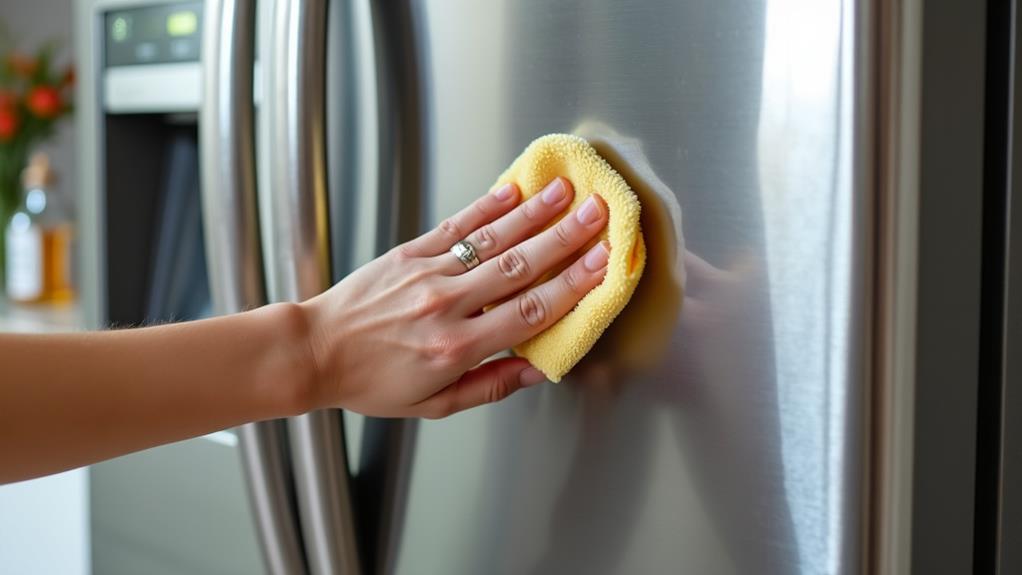
Once your appliance is clean, select an appropriate oil such as olive or baby oil for application. Apply a small amount onto a clean, soft cloth and wipe it across the stainless steel surface following the direction of the grain. Finish by buffing with a dry microfiber cloth to enhance the shine and preserve the finish.
Choosing the Right Oil
Selecting the appropriate oil for cleaning stainless steel appliances is crucial for maintaining their appearance. Both baby oil and olive oil are effective choices. Baby oil imparts a subtle shine, while olive oil offers a natural, non-toxic solution.
To clean, apply the oil in the direction of the stainless steel grain to prevent streaks and achieve a polished look. Use a clean microfiber cloth to apply a small amount of oil, minimizing product use and avoiding buildup. After application, buff the surface with another dry microfiber cloth to remove excess oil and enhance the shine.
Regular oil application not only keeps appliances looking pristine but also creates a protective layer that minimizes fingerprints and smudges. This helps maintain the clean appearance of your kitchen.
Olive oil is particularly noted for its non-toxic properties, making it a safe and effective option for households.
Step-by-Step Application
To begin the application process, thoroughly clean your stainless steel surface with a mixture of water and dish soap. This removes any loose dirt and grime, ensuring a clean slate for oil application.
Once the surface is dry, apply a small amount of olive oil onto a clean, soft microfiber cloth to guarantee a light and even application.
Next, wipe the oiled cloth along the grain of the stainless steel. This step effectively removes fingerprints and smudges while enhancing the shine.
Here are some tips to make this process easier:
- Wipe in small sections: Ensures even coverage and prevents missed spots.
- Use gentle pressure: Too much pressure can spread the oil unevenly.
- Reapply oil if needed: If you notice any dry patches, add a bit more oil to the cloth.
After wiping, use a separate dry cloth to buff the surface. This removes any excess oil and achieves a streak-free finish, leaving a beautiful protective film.
For ongoing maintenance, repeat this oil application process periodically. This not only protects the surface but also keeps your stainless steel appliances looking shiny and new.
Maintaining the Finish
Properly maintaining the finish of your stainless steel appliances is essential for longevity and aesthetics. In addition to thorough cleaning, regular oil application plays a crucial role.
Use a small amount of olive oil or baby oil on a soft microfiber cloth to clean and enhance the surface's shine. Always wipe along the grain of the stainless steel to avoid streaks and achieve a polished finish.
After applying the oil, use a dry microfiber cloth to buff the surface. This step removes any excess residue and promotes a streak-free shine, making your appliances look pristine.
Regular oil application creates a protective layer on the stainless steel, preventing fingerprints and smudges from accumulating.
Incorporating oil into your maintenance routine significantly improves the appearance and longevity of your stainless steel surfaces. Your appliances won't only look new but also stay protected longer.
Make it a habit to maintain the finish with this straightforward method, and your stainless steel appliances will remain in excellent condition.
Buffing and Polishing
To achieve a flawless finish on your stainless steel appliances, start with the right technique. First, apply a light, even layer of oil. Then, use a clean microfiber cloth, which is ideal for lifting and trapping dirt without leaving any residue.
Always buff in the direction of the grain to avoid scratches and achieve a smooth, polished finish. This method not only enhances the shine but also minimizes future smudges and fingerprints.
Buff the oil into the stainless steel until a protective layer forms. This layer is crucial for corrosion prevention and prolongs the lifespan of your appliances. Avoid using too much oil, as excess oil can attract dust and create a grimy appearance over time.
Regular buffing and polishing will keep your appliances looking their best.
Here are some quick tips to keep in mind:
- Buff in the grain direction: Ensures a smooth finish and prevents scratches.
- Use a clean microfiber cloth: Helps achieve a streak-free shine.
- Apply oil lightly and evenly: Excess oil can attract dust and grime.
Maintenance Tips
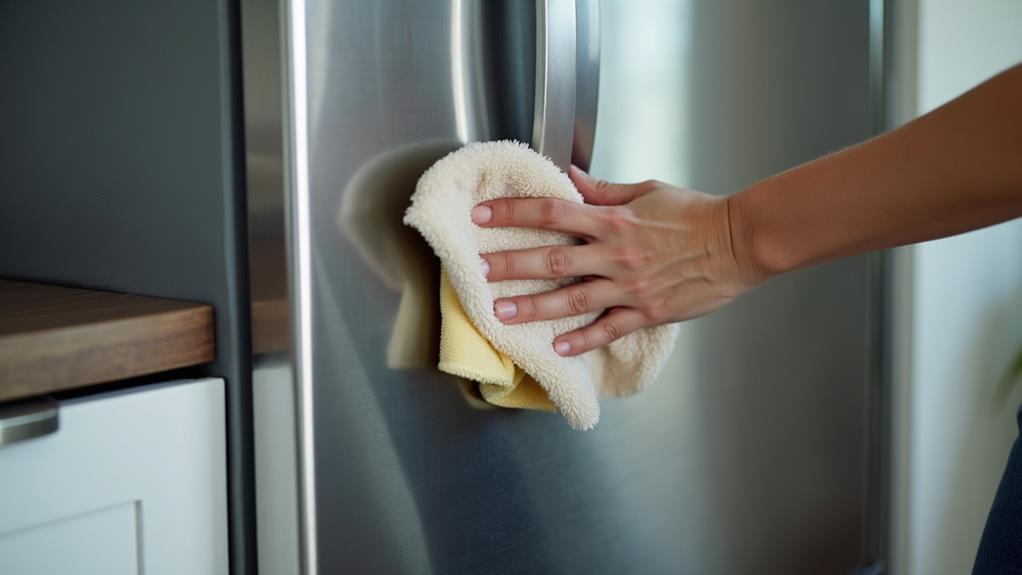
Maintaining the shine and cleanliness of your stainless steel appliances requires consistent effort. Regularly applying a small amount of olive oil can protect and enhance the shine of your stainless steel surfaces.
After cleaning, use a soft microfiber cloth to buff the surface in the direction of the grain. This technique helps achieve a streak-free finish and preserves the appliance's texture.
Establish a weekly cleaning routine to prevent grime build-up. A consistent maintenance schedule ensures your appliances remain looking new.
When cleaning, always use natural oils like olive oil instead of harsh chemicals. These natural oils not only clean but also protect your stainless steel from future fingerprints and smudges.
Avoid abrasive materials that can damage the stainless steel finish. Instead, use soft microfiber cloths, as they clean and polish without scratching the surface.
Wiping in the direction of the grain further minimizes streaks and enhances the overall shine.
Incorporating these maintenance tips into your routine will keep your stainless steel appliances looking their best. A little effort and the right materials go a long way in maintaining the pristine appearance of your kitchen fixtures.
Conclusion
By following these steps, you'll keep your stainless steel appliances looking their best. Using oil not only enhances their shine but also creates a protective barrier against fingerprints and smudges. Stick to a regular maintenance routine to prolong the life of your appliances. With minimal effort and the right materials, you'll enjoy spotless, gleaming surfaces that elevate the look of your kitchen. Happy cleaning and shining!

